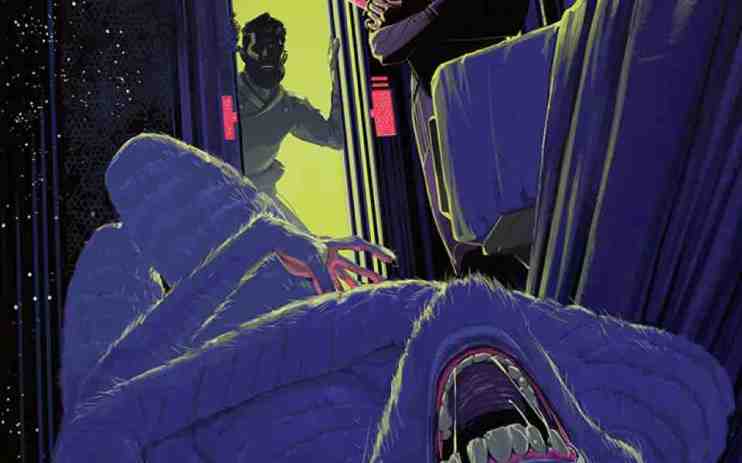The Long Way To A Small Angry Planet illustrator interview

To celebrate the 10 year anniversary of modern science fiction classic The Long Way To A Small Angry Planet, The Folio Society has released a hardback, illustrated edition limited to 750 hand-numbered copies. It features illustrations from acclaimed sci-fi artist Zoe Van Dijk. We caught up with her to talk about the landscape of science fiction in 2024 and the challenges of illustrating an author’s work.
What is it about science fiction that interests you?
Ultimately science fiction is an optimistic genre. Regardless of how dystopic the storyline is, the storyteller believes that we’ll make it as a species for another 100 years, another 1,000 years. Given the state of the world, I love that tendency to look forward. It’s a form of escapism, absolutely, but with plausible futures built on human engineering and fortitude.
How is science fiction in 2024?
When I was growing up in the 90s and early 2000s it felt like such an inaccessible genre, especially as a woman. Most of the books available to me were written by white men and the plots had so much blatant sexism in them: they didn’t feel like welcoming spaces. Now we’re having such an incredible renaissance of books and film being created or written by women and people of color, and all of these narratives are adding so much nuance and depth to the genre.
Who are your favourite sci-fi illustrators?
To be completely honest, I don’t look at that much sci-fi art! Or at least, I don’t consume it any more than I do any other genre. There are the legends that I think we can all agree we adore and look up to — Greg Manchess, Dan Dos Santos, Donato Giancola — but I don’t find myself reaching for other artists’ aesthetics nearly as much as I find myself pulling from cinematographers and film when I need inspiration. I am a huge fan of Robert Elswit and Roger Deakins. What Roger Deakins did with Bladerunner 2049 was incredible — there are scenes from that movie that are lasered into my brain. The way that cinematographers have to manipulate light and shadow to frame their subjects in service of the narrative or the mood is something I’m always pushing in my own work.
Do you have a dream sci-fi writer whose work you’d love to illustrate?
I would love, love, love to illustrate a Neal Stephenson novel. Snowcrash and Neuromancer were both such important books to me when I first read them. Cyberpunk sci-fi is such a fun genre to me. It’s colorful and fast and often charmingly kitsch but also full of interesting, mind bending science.
Did you work closely with the author?
Becky was involved in approving me as the artist but after that point I was set free in the wild tundra of my imagination! After the initial ideation stage, I spent a lot of time collaborating with Sheri Gee at the Folio Society on the design and color palette. Many of our decisions were catered around the dictation and specifics of the printing process — there are things you can and just can’t achieve with block printing.
Were you already a fan of The Long Way To A Small Angry Planet or were you reading it for the first time
I read The Long Way To A Small Angry Planet when it first came out, and then reread it when Sheri approached me to illustrate the Folio edition. I enjoyed it both times but the second was perhaps more impactful. I find I often connect more meaningfully with books when I am reading them for illustration — I’m visualizing and engaging with the material in a more inquisitive way than just being a passive consumer.
What were the specific challenges?
The Long Way To A Small Angry Planet was interesting because it has a lot of aliens in it — like, a whole lot of aliens! I had never spent much time designing or illustrating aliens or foreign bodied humanoids before. Beyond just designing them, I also had to humanize them at the same time and give them emotion. It was a really interesting visual problem, one that I’d never solved before, and I enjoyed it a lot!
What are the challenges in creating illustrations for science fiction?
I am a staunch believer that in order to make science fiction art, you have to love the science just as much as the fiction. It’s in the name! You have to appreciate the mechanics, the hard world building, the exacting math. But the pitfall of all this pneumatic precision is it can sometimes be a little cold, a little devoid of humanity. You have to find a way to put the magic back into it. I actually think the problems of solving the coldness of science and predicting an aesthetic kind of solve each other. One of my favorite things is media that gets it half right as time progresses — the way that the movie Hackers imagines the internet (when we log on to dial up we go on a wild and wacky journey through cities of circuit boards? hell yeah), the way that Star Trek TNG never anticipated touch screens. I look at this media and it seems so charmingly human, so ahead of its time but also endearingly out of touch — time softened the hard science and created its own bizarre magic. So I’m never really trying to withstand the test of time. All I can do is make the work I make. No matter what I do, everything will get polished into a new shape over the years.
To buy a copy go to the Folio website here
